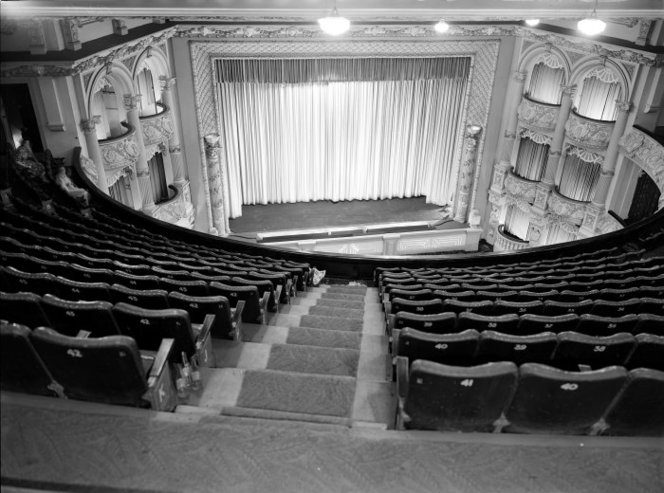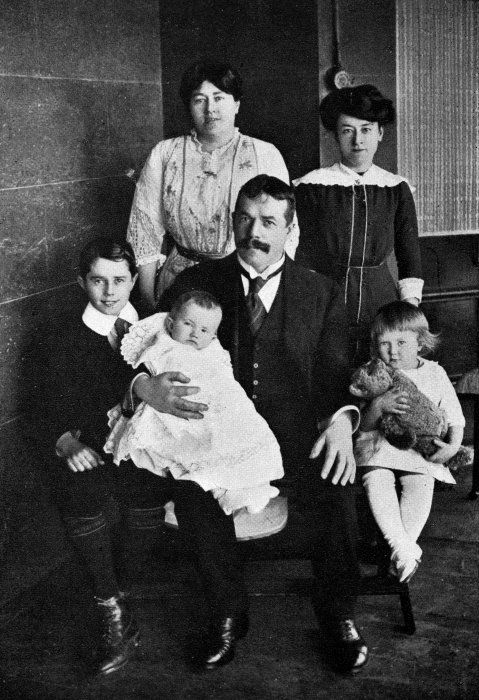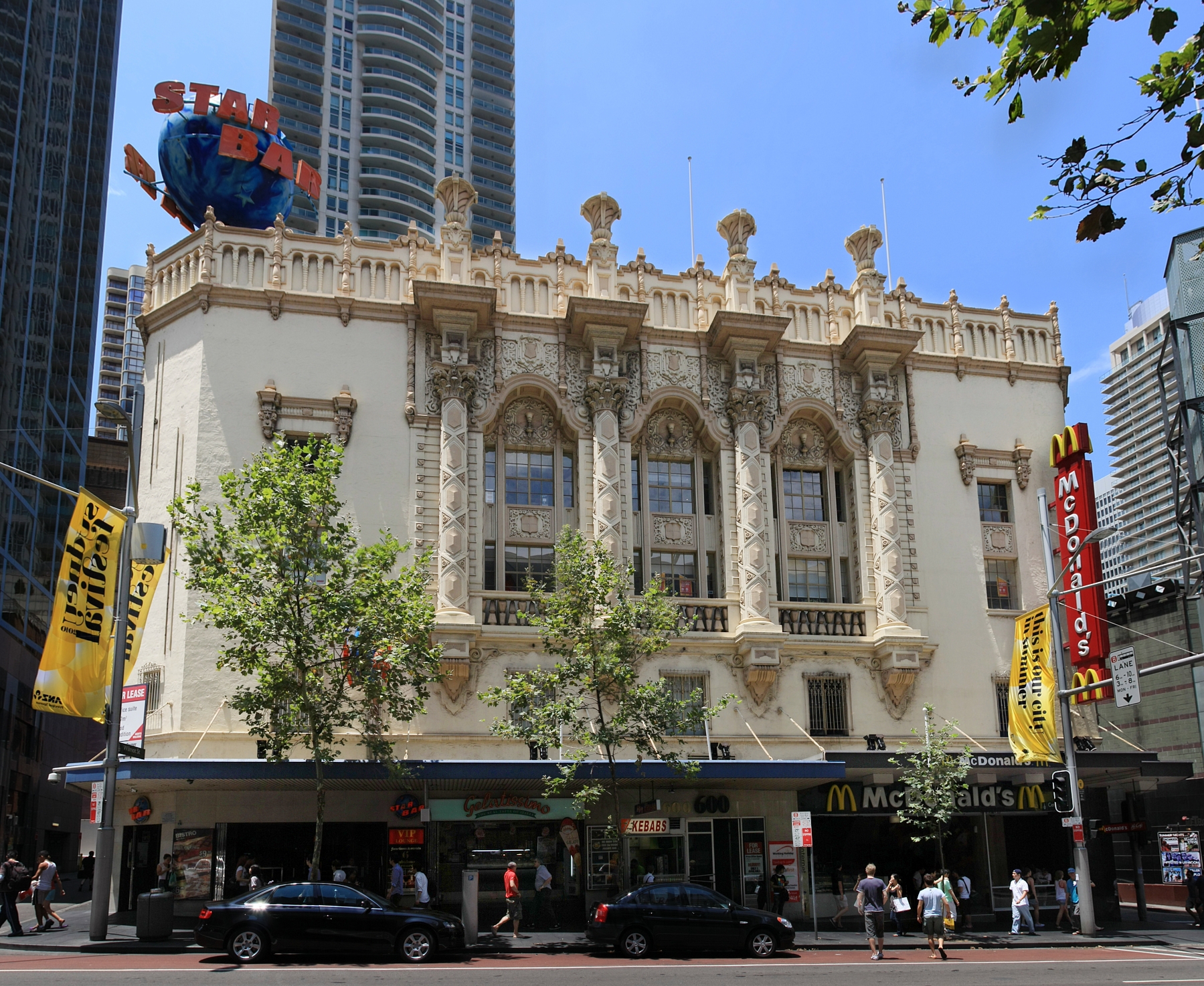|
Henry Eli White
Henry Eli White (21 August 1876 – 3 March 1952), also known as Harry White, was a New Zealand-born architect who is best known for the many theatres and cinemas he designed in Australia and New Zealand in the 1910s and 1920s. Many of the major surviving historic venues in the two countries are White designs, including the St. James Theatre, Wellington, St. James Theatre, Auckland, the Capitol Theatre and State Theatre in Sydney, and the Palais Theatre and the interiors of the Princess Theatre and Athenaeum Theatre in Melbourne. He also designed the City Hall and the attached Civic Theatre in Newcastle, New South Wales. Personal life White was born on 21 August 1876 at Dunedin, New Zealand, son of English migrant parents Joseph Eli White and wife Susanna. Joseph Eli White established himself as a bricklayer then a builder and contractor, and by the 1900s he had built many major landmarks in Dunedin, and been elected Councillor and Mayor of the municipality of North East ... [...More Info...] [...Related Items...] OR: [Wikipedia] [Google] [Baidu] |
Dunedin
Dunedin ( ; mi, Ōtepoti) is the second-largest city in the South Island of New Zealand (after Christchurch), and the principal city of the Otago region. Its name comes from , the Scottish Gaelic name for Edinburgh, the capital of Scotland. The city has a rich Scottish, Chinese and Māori heritage. With an estimated population of as of , Dunedin is both New Zealand's seventh-most populous metro and urban area. For historic, cultural and geographic reasons the city has long been considered one of New Zealand's four main centres. The urban area of Dunedin lies on the central-eastern coast of Otago, surrounding the head of Otago Harbour, and the harbour and hills around Dunedin are the remnants of an extinct volcano. The city suburbs extend out into the surrounding valleys and hills, onto the isthmus of the Otago Peninsula, and along the shores of the Otago Harbour and the Pacific Ocean. Archaeological evidence points to lengthy occupation of the area by Māori prior to the ar ... [...More Info...] [...Related Items...] OR: [Wikipedia] [Google] [Baidu] |
Ben Fuller (producer)
Sir Benjamin John Fuller (20 March 1875 – 10 March 1952) was an English-born Australian theatrical entrepreneur. Biography Benjamin John Fuller was born on 20 March 1875 in Shoreditch, London to compositor John Fuller (senior) and Harriett, ''née'' Jones. From December 1884 to February 1885 young Ben appeared in a juvenile production of ''The Pirates of Penzance'' at the Savoy Theatre; two years later he was a member of Montague Robey's Midget Minstrels and later joined Warwick Gray's Juvenile Opera Company. Ben's father, John Fuller Snr., a tenor, gave up his day job as a compositor when he was invited to join the songwriter Harry Hunter's Mohawk Minstrels in October 1881. In 1889, John Fuller Snr. accepted an invitation to tour Australia with the London Pavilion Company and arrived in Melbourne aboard the ''Cuzco'' on 3 August 1889. After the company disbanded in January 1890, John Fuller Snr. decided to stay in Australia as he could see great opportunities in the theatre ... [...More Info...] [...Related Items...] OR: [Wikipedia] [Google] [Baidu] |
Blenheim, New Zealand
Blenheim ( ; mi, Waiharakeke) is the most populous town in the regions of New Zealand, region of Marlborough Region, Marlborough, in the north east of the South Island of New Zealand. It has an urban population of The surrounding Marlborough wine region is well known as the centre of the New Zealand wine industry. It enjoys one of New Zealand's sunniest climates, with warm, relatively dry summers and cool, crisp winters. Blenheim is named after the Battle of Blenheim (1704), where troops led by John Churchill, 1st Duke of Marlborough defeated a combined French and Bavarian force. The New Zealand Ministry for Culture and Heritage gives a translation of "Phormium tenax, flax stream" for . History The sheltered coastal bays of Marlborough supported a small Māori people, Māori population possibly as early as the 12th century. Archaeological evidence dates Polynesian human remains uncovered at Wairau Bar to the 13th century. The rich sea and bird life of the area would easil ... [...More Info...] [...Related Items...] OR: [Wikipedia] [Google] [Baidu] |
Hayden Orpheum Picture Palace
The Hayden Orpheum Picture Palace, also known and originally as the Cremorne Orpheum Theatre, is a heritage-listed cinema located at 380 Military Road, in the northern Sydney suburb of Cremorne in the North Sydney Council local government area of New South Wales, Australia. It was designed by George Newton Kenworthy and built in 1935 by F. T. Eastment and Sons. It was added as a Heritage Item to the North Sydney Local Environmental Plan 2013 on 2 August 2013. The architect, George Newton Kenworthy, is known for his work in the Art Deco style, and most particularly his designs for theatres and cinemas including the Enfield Savoy Theatre (alterations 1938), the Majestic Theatre in Port Macquarie (1936), and the Regent Theatre in Mudgee (1935). History The Italian-Australian Virgona family led by director Angelo Virgona, who had opened the North Sydney Orpheum on the corner of Alfred Street and Junction Street in North Sydney in 1913 and renovated into a more modern style in 1 ... [...More Info...] [...Related Items...] OR: [Wikipedia] [Google] [Baidu] |
George Newton Kenworthy
George Newton Kenworthy FRAIA, also known as G. N. Kenworthy or "Kennie" (1885 – 28 October 1954), was a leading Sydney architect and Fellow of the Royal Australian Institute of Architects best associated for his work in partnership with Henry Eli White and for his building designs (particularly theatres) in the Art Deco, Streamline Moderne, Functionalist and Spanish Mission styles. Early life Kenworthy was born in 1885 in Manchester, England and was first educated at Trinity Grammar School and the Victoria School of Arts in Lancashire. He studied architecture at the University of Liverpool School of Architecture and qualified as an architect in 1906. First articled to Francis Redfern, Kenworthy worked for several leading architectural firms in England before starting his own practice in 1909 in Southport. Practice in Australia In 1911 Kenworthy moved to Sydney, Australia, taking up a position in the New South Wales Government Architect's Office, where he remained until 192 ... [...More Info...] [...Related Items...] OR: [Wikipedia] [Google] [Baidu] |
Plaza Theatre (Sydney)
The former Plaza Theatre in Sydney, New South Wales is a heritage-listed building designed as a 2000-seat cinema by Eric Heath for the Hoyts Group, and opened in 1930. It is no longer used as a cinema. Location The building is located at 600 George Street, Sydney on the western half of the block bounded by Wilmot Street and Central Street to the sides and Pitt Street to the rear. It is a prominent feature of the entertainment sector's streetscape. History The Plaza Theatre was built during a ''golden age'' of cinema-going in[Australia and was opened on 11 April 1930.The Heritage of Australia, Macmillan Company, 1981, p.2/102 designed as a 2000-seat cinema by Eric Heath for Hoyts.Heritage Branch Retrieved 20.6.2008 The theatre's organ was built circa 1923 by the Rudolph Wurlitzer Company of North Tonaw ... [...More Info...] [...Related Items...] OR: [Wikipedia] [Google] [Baidu] |
Bunnerong Power Station
Bunnerong Power Station was a coal-fired power station in the south-eastern Sydney suburb of Matraville, New South Wales, Australia that was decommissioned by 1975 and subsequently demolished. When the last generating units were commissioned, it was the largest power station in the southern hemisphere, with a capacity of 375 megawatts (MW) from eleven turbo-alternators. It was able to supply up to one third of the state's electricity needs at the time. It remained the most powerful until the completion of Vales Point Power Station in 1966. In 1924, the 117-acre site for the power station was chosen. The station was located on Bunnerong Road in Matraville. Bunnerong 'A' Station - 175 MW Bunnerong was originally built with eighteen cross drum boilers from Babcock & Wilcox Ltd (UK), supplying steam at and , with each boiler producing of steam. Six 25 megawatt (MW) Metropolitan-Vickers two-cylinder turbo-alternators were built between 1926 and 1930 by the Electricity Depar ... [...More Info...] [...Related Items...] OR: [Wikipedia] [Google] [Baidu] |
John Eberson
John Adolph Emil Eberson (January 2, 1875 – March 5, 1954) was an Austrian-American architect best known for the development and promotion of movie palace designs in the atmospheric theatre style. He designed over 500 theatres in his lifetime, earning the nickname "Opera House John". His most notable surviving theatres in the United States include the Tampa Theatre (1926), Palace Theatre (1928), Majestic Theatre (1929), Akron Civic Theatre (1929) and Paramount Theatre (1929). Remaining international examples in the atmospheric style include both the Capitol Theatre (1928) and State Theatre (1929) in Sydney, Australia, The Forum (1929, Melbourne, Australia) and Le Grand Rex (1932, Paris, France). Life and career John Adolf Emil Eberson was born in Czernowitz, Bukovina, Austria-Hungary, now south western Ukraine, on January 2, 1875. He was the son of Sigfried and Lora (Schmidt) Eberson. He attended high school in Dresden, Saxony and studied electrical engineering at the Unive ... [...More Info...] [...Related Items...] OR: [Wikipedia] [Google] [Baidu] |
George Birch (Australian Businessman)
George Henry Birch (1862–1917) was an Australian businessman, best known for co-founding the Birch, Carroll & Coyle cinema chain, with E. J. Carroll, Dan Carroll and Virgil Coyle. Early life Birch was born in Kingston upon Hull, Hull, Yorkshire in 1862,Personal News ''The Morning Bulletin'', 20 August 1917. Retrieved 11 March 2017. but migrated to Australia as a young man, where he commenced work as a customs officer at the Customs House, Rockhampton, Rockhampton Customs Department in Queensland. Hotel management career After his marriage to Mary Ann Cannon on 3 October 1888 Birch resigned from his customs job to begin a career managing hotels, beginning with the Grand Hotel in the seaside village of Emu Park, Queensland, Emu Park with his wife. From 1892, Birch became the lesse ...[...More Info...] [...Related Items...] OR: [Wikipedia] [Google] [Baidu] |
Adam Style
The Adam style (or Adamesque and "Style of the Brothers Adam") is an 18th-century neoclassical style of interior design and architecture, as practised by Scottish architect William Adam and his sons, of whom Robert (1728–1792) and James (1732–1794) were the most widely known. The Adam brothers advocated an integrated style for architecture and interiors, with walls, ceilings, fireplaces, furniture, fixtures, fittings and carpets all being designed by the Adams as a single uniform scheme. Commonly and mistakenly known as "Adams Style", the proper term for this style of architecture and furniture is the "Style of the Adam Brothers". The ''Adam style'' found its niche from the late 1760s in upper-class and middle-class residences in 18th-century England, Scotland, Russia (where it was introduced by Scottish architect Charles Cameron), and post- Revolutionary War United States (where it became known as Federal style and took on a variation of its own). The style was superse ... [...More Info...] [...Related Items...] OR: [Wikipedia] [Google] [Baidu] |
Louis Quinze
The Louis XV style or ''Louis Quinze'' (, ) is a style of architecture and decorative arts which appeared during the reign of Louis XV. From 1710 until about 1730, a period known as the Régence, it was largely an extension of the Louis XIV style of his great-grandfather and predecessor, Louis XIV. From about 1730 until about 1750, it became more original, decorative and exuberant, in what was known as the Rocaille style, under the influence of the King's mistress, Madame de Pompadour. It marked the beginning of the European Rococo movement. From 1750 until the King's death in 1774, it became more sober, ordered, and began to show the influences of Neoclassicism. Architecture The chief architect of the King was Jacques Gabriel from 1734 until 1742, and then his more famous son, Ange-Jacques Gabriel, until the end of the reign. His major works included the Ecole Militaire, the ensemble of buildings overlooking the Place Louis XV (now Place de la Concorde; 1761-1770), and the P ... [...More Info...] [...Related Items...] OR: [Wikipedia] [Google] [Baidu] |








